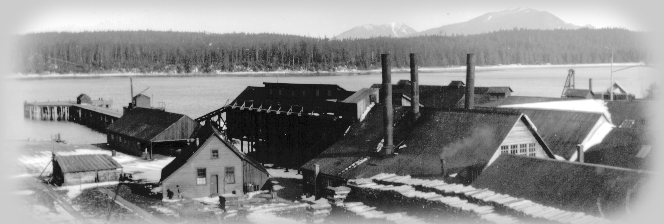Vessels, Gear, and Fishing Efficiency of the Killisnoo Plant

(Vincent Soboleff collection, PCA 1-339, Alaska State Library--click to enlarge)
----WARNING: "ALPHA" Draft Status This page is still under major development!!
---Text is not intended to be readable---for author's use only!!!!
The Killisnoo plant had at least three large steam vessels for tending their Norwegian seine operations: the Dolphin, the Lincoln, and the Favorite. The plant continued to use the Norwegian seine long after other plants had shifted to smaller more efficient vessels with internal combustion engines (ref. - Cobb?). Increasing efficiency of the herring fleet (power, range and other factors) had much to do with maintaining high catches in the face of declining herring abundance. The
Walter Soboleff recalls with pride how a crew of shipwrights were crafting the Dolphin, right there in Killisnoo. The Dolphin had been originally built in 1886 in Astoria, Oregon, as a steam tugboat, 87.5 feet length, 22.4 feet beam, drawing 8.7 feet, 149 gross tons and 88 net (early Blue Books list her 84 gross and 60 net) (index card for "Dolphin - Old Killisnoo Herring Steamer", Lloyd A. "Kinky" Bayer General Marine File Collection, Alaska State Library) At some point she whttp://www.essortment.com/all/whaleoil_redd.htmas purchased by the Northwest Trading Company for fisheries work, and brought to Killisnoo. Plate PCA-1-532 shows the Dolphin hauled out on the marine ways at Killisnoo, before the rebuilding, outfitted with a forward wheelhouse, simple mast, and small round portlights in the curved bulwarks on her stern's counter. In Plates PCA-1-533 and 534 (side view) she is completely stripped down to her backbone. Cabins and decks are removed, and apparently her entire hull planking and its ceiling. The bare skeleton formed by her frames and backbone lies naked on the beach, with numerous logs surrounding her which might be readied for use for planking stock. Plate PCA-1-536 shows a transformed Dolphin, in spanking new paint, making her way toward the Killisnoo dock with decks lined with neatly dressed men in fine clothes posing for the camera, which appears to be the day of her relaunching. The wheelhouse is now aft, halibut schooner style, and a larger cargo mast is placed well forward, with a heavy elevated gaff, considerable rigging with heavy tackle for lifting fishing gear. A deck doghouse is forward, with a stovepipe emerging from its roof. Another photo shows her with a large, lower boom with a sail bent on, presumably a riding sail for steadying her at sea, though the sail has considerable area for a vessel of her size. She carries two skiffs for the Norwegian seine, and apparently some smaller craft for going ashore as well. The skiffs are under tow in several photos, likely done when weather permitted.
The Favorite was an 80 foot steam-powered vessel built at Portland, Oregon, in 1874. She was purchased by the Northwest Trading Company in 1880, outfitted and first captained by Captain James W. Keene, being initially used by the company for whaling work. She was several times chartered by the Navy for survey work and was a frequent early visitor in Juneau. Serving her owners as a trading vessel and later as a fishing vessel for the herring reduction plant at Killisnoo, she continued in operation until about 1900 (source). It was the Favorite that was involved in the infamous naval bombardment of Angoon in the fall of 1882. The Favorite carried the plant superintendant, Capt. J. M. Vanderbilt, to Sitka in his request for naval assistance, and later returned to assist that naval forces in their action (source).
Norwegian Seine Method" http://content.cdlib.org/xtf/view?docId=kt3z09n6cs&doc.view=frames&chunk.id=d0e77&toc.id=d0e374&brand=calisphere http://books.google.com/books?id=K7UgAAAAMAAJ&pg=PR12&lpg=PR12&dq=%22norwegian+seine%22&source=web&ots=3YKI5CEcpN&sig=SqYRkJwzrTYBWHhtYJL9OllliI0&hl=en#PPA493,M1
When the Killisnoo plant opened in 1882, the old Norwegian method of seining was used. In this method two large skiffs, each manned by about eight men and each containing half of the 200 fathom seine were rowed about 20 to 30 feet apart in search of a school of herring. When a school was found, the skiffs attempted to encircle the school by rowing in opposite directions and setting the seine as they rowed. Pursing the seine was done by hand, and the fish were then brailed into a larger powered vessel. Purse seining from power boats was introduced shortly after 1900. By 1922, powered purse seine vessels were used by all except the Killisnoo and Big Port Walter plants (Rounsefell 1930). Norwegian seining was used by some fishermen as late as 1927 (Huizer 1952). Early purse seine vessels were relatively small and gasoline powered. Larger diesel powered vessels became common during the peak years of the reduction fishery. Purse seines used in the reduction fishery resembled salmon purse seines, but used wire cable for the purse line and were deeper, longer, and heavier than salmon purse seines.
Seine Gear in Later Years The internal combustion engine, when it finally arrived on the fishing grounds did so with a bang. The first internal combustion engine in the Pacific Northwest fleet was the 30 foot Puget Sound seiner "Pioneer", with her 5 hp gasoline engine; by 1912 all of the salmon and halibut fleets were powered by internal combustion engines (Browning 1974).
Back to: History of Southeast Alaska Herring Fisheries
Link to: References
Caution: These pages contain preliminary research results, and are presented here only to further collaborative research and analysis. The information presented has not been fully analyzed or verified for correctness. Please consult the original literature citations for authentic interpretations or contact the author regarding applications of any analysis presented on these pages.
For more information, contact Fritz Funk:
fritz funk.io
| Last modified: Apr 12, 2008 at 21:14:42
funk.io
| Last modified: Apr 12, 2008 at 21:14:42

